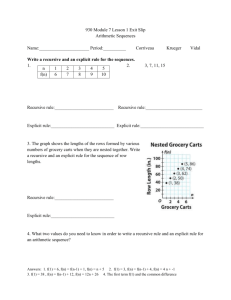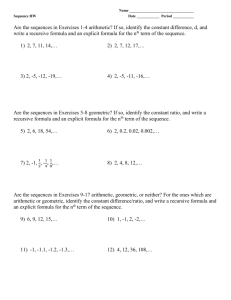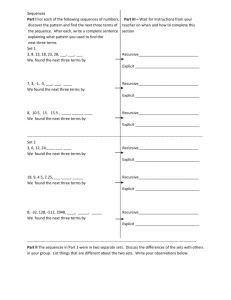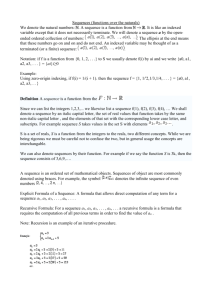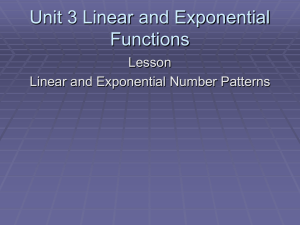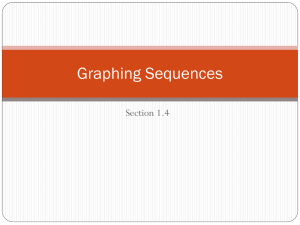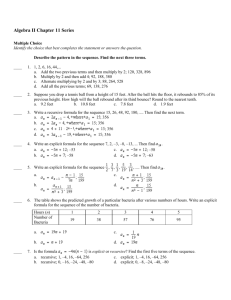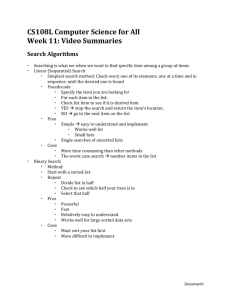DOC - JMap
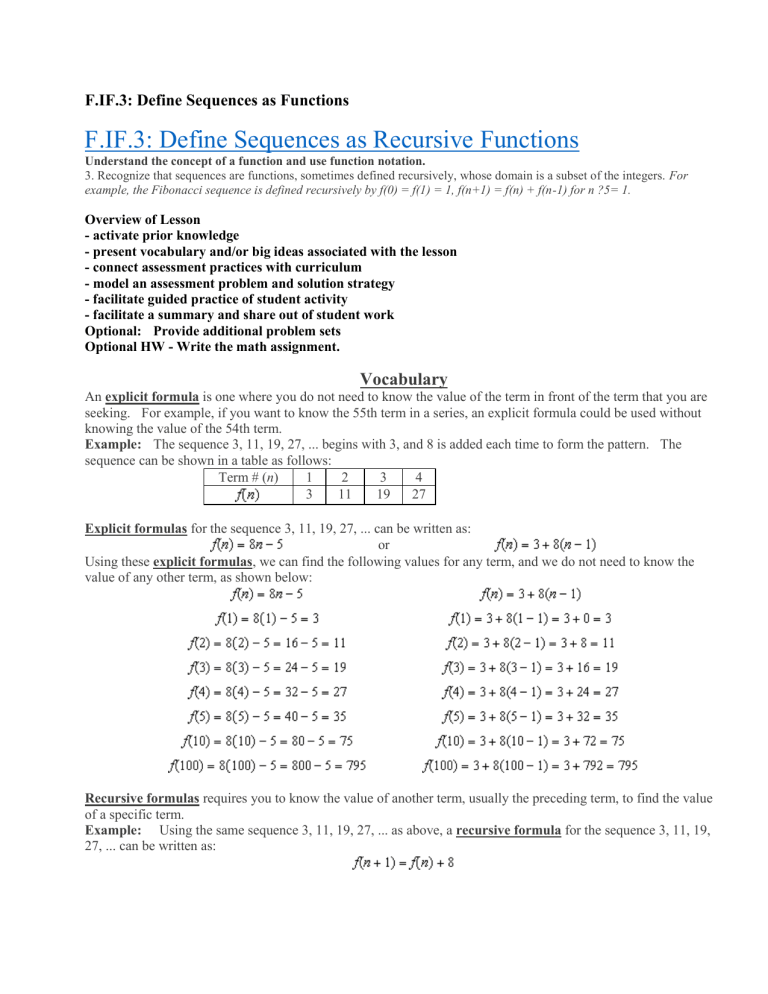
F.IF.3: Define Sequences as Functions
F.IF.3: Define Sequences as Recursive Functions
Understand the concept of a function and use function notation.
3. Recognize that sequences are functions, sometimes defined recursively, whose domain is a subset of the integers. For example, the Fibonacci sequence is defined recursively by f(0) = f(1) = 1, f(n+1) = f(n) + f(n-1) for n ?5= 1.
Overview of Lesson
- activate prior knowledge
- present vocabulary and/or big ideas associated with the lesson
- connect assessment practices with curriculum
- model an assessment problem and solution strategy
- facilitate guided practice of student activity
- facilitate a summary and share out of student work
Optional: Provide additional problem sets
Optional HW - Write the math assignment.
Vocabulary
An explicit formula is one where you do not need to know the value of the term in front of the term that you are seeking. For example, if you want to know the 55th term in a series, an explicit formula could be used without knowing the value of the 54th term.
Example: The sequence 3, 11, 19, 27, ... begins with 3, and 8 is added each time to form the pattern. The sequence can be shown in a table as follows:
Term # ( n ) 1 2 3 4
3 11 19 27
Explicit formulas for the sequence 3, 11, 19, 27, ... can be written as:
or
Using these explicit formulas , we can find the following values for any term, and we do not need to know the value of any other term, as shown below:
Recursive formulas requires you to know the value of another term, usually the preceding term, to find the value of a specific term.
Example: Using the same sequence 3, 11, 19, 27, ... as above, a recursive formula for the sequence 3, 11, 19,
27, ... can be written as:
This recursive formula tells us that the value of any term in the sequence is equal to the value of the term before it plus 8. A recursive formula must usually be anchored to a specific term in the sequence (usually the first term), so the recursive formula for the sequence 3, 11, 19, 27, ... could be anchored with the statement
Using this recursive formula , we can reconstruct the sequence as follows:
Observe that the recursive formula
includes two different values of the dependent variable, which in this example are and , and we can only reconstruct our original sequence using this recursive formula if we know the term immediately preceding the term we are seeking.
Two Kinds of Sequences
arithmetic sequence (A2T) A set of numbers in which the common difference between each term and the preceding term is constant.
Example: In the arithmetic sequence 2, 5, 8, 11, 14, … the common difference between each term and the preceding term is 3. A table of values for this sequence is:
Term # ( n ) 1
2
2
5
3
8
4 5
11 14
An explicit formula for this sequence is
A recursive formula for this sequence is: geometric sequence (A2T) A set of terms in which each term is formed by multiplying the preceding term by a common nonzero constant.
Example: In the geometric sequence ... the common ratio is 2. Each
term is 2 times the preceding term. A table of values for this sequence is:
Term ( n ) 1 2 3 4 5
2 4 8 16 32
An explicit formula for this sequence is
A recursive formula for this sequence is:
REGENTS PROBLEMS
1. If and , then a. b. 11 c. 21 d. 43
2. A sunflower is 3 inches tall at week 0 and grows 2 inches each week. Which function(s) shown below can be used to determine the height,
I.
, of the sunflower in n weeks?
II.
III. a. I and II b. II, only
3. If a sequence is defined recursively by a. 1 c. III, only d. I and III
and c. 5
for , then is equal to
b. d. 17
4. Which recursively defined function has a first term equal to 10 and a common difference of 4? a. c. b. d.
F.IF.3: Define Sequences as Functions
Answer Section
1. ANS: D
Strategy: Use the recursive formula: to find each term in the sequence.
PTS: 2
Weeks
( n )
Height
REF: 081424a1 NAT: F.IF.3 TOP: Sequences
2. ANS: D
Strategy: If sunflower’s height is modelled using a table, then the three formulas can be tested to see which one(s) produce results that agree with the table.
0 3
1
2
5
7
3 9
Formula I, , is an explicit formula that agrees with the table.
Formula II is an explicit formula that does not agree with the table.
Formula III, , is a recursive formula that agrees with the table.
PTS: 2
3. ANS: C
REF: 061421a1
Strategy: Use the recursive formula:
NAT: F.IF.3 TOP: Sequences
to find each term in the sequence.
Answer choice c corresponds to
PTS: 2 REF: 011520a1
.
NAT: F.IF.3 TOP: Sequences
4. ANS: A
Strategy: Eliminate wrong answers.
Choices b and d have first terms equal to 4, but the problem states that the first term is equal to 10. Therefore, eliminate choices b and d .
A common difference of 4 requires the addition or subtraction of 4 to find the next term in the sequence.
Eliminate choice c because choice c multiplies the preceding term by 4.
Choice a is correct because the first term is 10 and 4 is added to each preceding term.
PTS: 2 REF: 081514ai NAT: F.IF.3 TOP: Sequences
Standard “Writing the Math” Assignment
START
PART 1.
PART 2.
PART 3.
PART 4.
PART 5.
PART 6.
Write your name, date, topic of lesson, and class on your paper.
Copy the problem from the lesson and underline/highlight key words.
State your understanding of what the problem is asking .
Answer the problem.
Explanation of strategy .
Create a new problem that addresses the same mathematical understandings.
State the answer to your new problem .
Clearly label each of the six parts.
Grading Rubric
Each homework writing assignment is graded using a four-point rubric, as follows:
Part 1. Statement of the problem. 1
point is awarded for correctly restating the
2 original problem.
Part 2. Statement of what the problem is really asking.
1
point is awarded for correctly identifying
2 what the problem is asking you to find or do.
Part 3. Solution to the problem. 1
point is awarded for a correct solution to
2 the problem.
Part 4. Written analysis of the mathematics and solution strategy involved in the problem.
Up to 1 point is awarded for an explanation of the mathematics and solution strategy involved in the problem.
Part 5. An alternative version of the problem. Up to 1 point is awarded for creating a new problem that involves similar mathematics and a similar solution strategy.
Part 6. Solution to the alternative version of the problem.
1
point is awarded for correctly solving the
2 new problem that you have created.
This assignment/activity is designed to incorporate elements of Polya’s four step universal algorithm for problem solving with the idea that writing is thinking.
Rationale for Assignment
Each New York Regents Algebra I (Common Core) examination contains 13 open response problems. An analysis of the first three Algebra I examinations revealed that approximately 51% (20 out of 39) of these open response problems instructed students to: 1) describe; 2) state ; 2) explain; 3) justify or otherwise write about their answers.
It is theorized that students can benefit from explicit instruction and writing routines that are applicable to solving these problems.
EXEMPLAR OF A WRITING THE MATH ASSIGNMENT
Student’s Name
Topic:
Date:
Class:
Part 1. The Problem
TOP Electronics is a small business with five employees. The mean (average) weekly salary for the five employees is $360. If the weekly salaries of four of the employees are $340, $340, $345, and $425, what is the salary of the fifth employee?
Part 2. What is the problem asking?
Find the salary of the fifth employee.
Part 3. Answer
The salary of the fifth employee is $350 per week.
Part 4. Explanation of Strategy
The arithmetic mean or average can be represented algebraically as:
X
x
1
x
2
...
n x n
I put information from the problem into the formula. The problem says there are 5 employees, so n
5 .
The problem also gives the mean (average) salary and the salaries of 4 of the employees. These numbers can be substituted into the formula as follows:
340 340 345 425
360
5
1800
340 340 345 425
x x
5
5
x
5
x
5
350
x
5
Check: 360
340 340 345 425 350
1800
5 5
360
Part 5. A New Problem
Joseph took five math exams this grading period and his average score on all of the exams is 88. He remembers that he received test scores of 78, 87, 94, and 96 on four of the examinations, but he has lost one examination and cannot remember what he scored on it. What was Joseph’s score on the missing exam?
Part 6. Answer to New Problem
Joseph received a score of 85 on the missing examination.
EVALUATION
Name and Proper Heading Part 4. Explanation of strategy. 1 Point
Part 1. Problem copied correctly?
Part 2. Understand the problem?
1/2 Point Part 5. New problem.
1/2 Point Part 6. Solution to new problem.
Part 3. Correct and complete answer? 1/2 Point
1 Point
1/2 Point
TOTAL 4 Points
